As noted from the exhibition Der ungesehene Designklassiker at the Deutsches Stuhlbaumuseum, Rabenau, alongside the introduction, re-introduction, enabled to the EW 1192 by Horst Heyder, a work that was, in all probability, the most widely found, most widely used, chair in the DDR and, potentially, one of the chairs existent in the greatest population densities anywhere ever, and thus a chair that inarguably shouldn't need to be re-introduced, but which on account of the nature of the development of Europe since 1989 sadly does, one also finds a contemporary 21st century re-design of the EW 1192 by Leipzig based designer Jacob Strobel.
A re-design that poses the question darf one re-design a work such as the EW 1192?, is one allowed to re-design a work such as the EW 1192?
¿Is one allowed to re-design a work that was one of the most widely found, most widely used, chairs in the (hi)story of a nation?
¿Is one allowed to re-design a work that so eloquently and succinctly allows access to more nuanced appreciations of the (hi)story of furniture design in the DDR?
¿Is one allowed to re-design a work that is one of the few surviving testaments to the work of Horst Heyder, an individual who played an important role in the development of furniture design in the DDR?
¿Is one allowed to re-design a work that is one of the few surviving testaments to the work of the Entwicklungsbüro Waldheim, an institution who played an important role in the development of furniture design in the DDR?
¿Is one allowed to re-design a work that is an artefact of daily life in the DDR, in a nation no longer existent?
¿Darfst du?
???
Standing in the Deutsches Stuhlbaumuseum looking at that contemporary re-design it occurred to us that there was one person particularly well placed to answer that question, one person who'd already considered it in a lot more detail than us. So we we asked them: ¿Is one allowed to re-design a work such as the EW 1192, Jacob Strobel?
¿Darfst du?
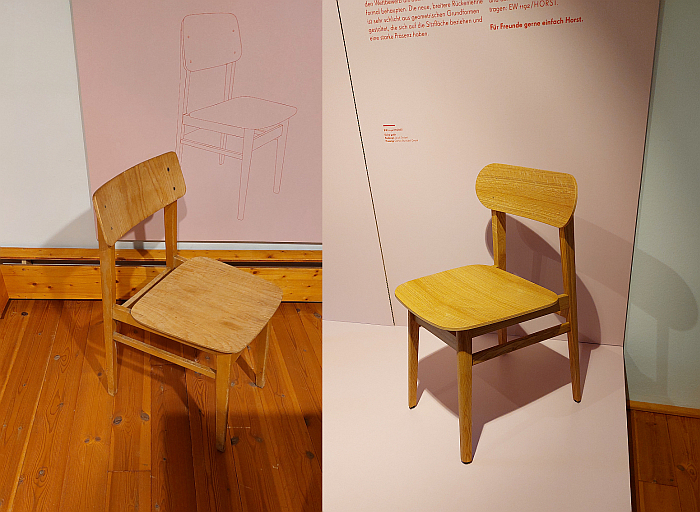
"'Darf' can be viewed on different levels, for example legal or moral. Nor should the context be neglected. However I reached a point where I not only realised that I was 'allowed to', but I had the feeling that I 'must'".
Born and raised in Würzburg Jacob Strobel completed a carpentry apprenticeship in his native Bavaria before studying Holzgestaltung, Wood (based) Design, at the Faculty for Angewandte Kunst in Schneeberg, in the heart of the Erzgebirge in southern Sachsen, a college that is and was the only one in Germany offering a Bachelor and Master in Wood Design. Upon his graduation in 2007 Jacob joined Austrian wooden furniture manufacturer Team 7, becoming Head of Design in 2008, a tenure he retained until 2015 when he swapped industry for academia, and Austria for Sachsen, returning to his alma mater in Schneeberg to take up the post of Professor for Wood Design and simultaneously head of the department. A return to Schneeberg that was also a re-acquaintance with a reduced, reserved, yet highly communicative and comfortable wooden chair he had first met, and first developed a fascination for, as a student, if a work, he, then, had had great difficulty localising, "I read it as Scandinavian design from the 1950s and 60s", he recalls, "in terms of design history, I was still at the beginning of my studies and, as a West German, I didn't know anything about DDR products". A lack of knowledge of, lack of affinity with, DDR furniture design he, arguably, shared with a great many East Germans: having returned to Sachsen, and once again regularly encountering the unassuming wooden chair at flea-markets and the like, when he asked, no-one could tell him who had produced it or where it came from or what it was called. Despite everyone being familiar with it. For a great many of the younger generation it was simply Granny's kitchen chair.
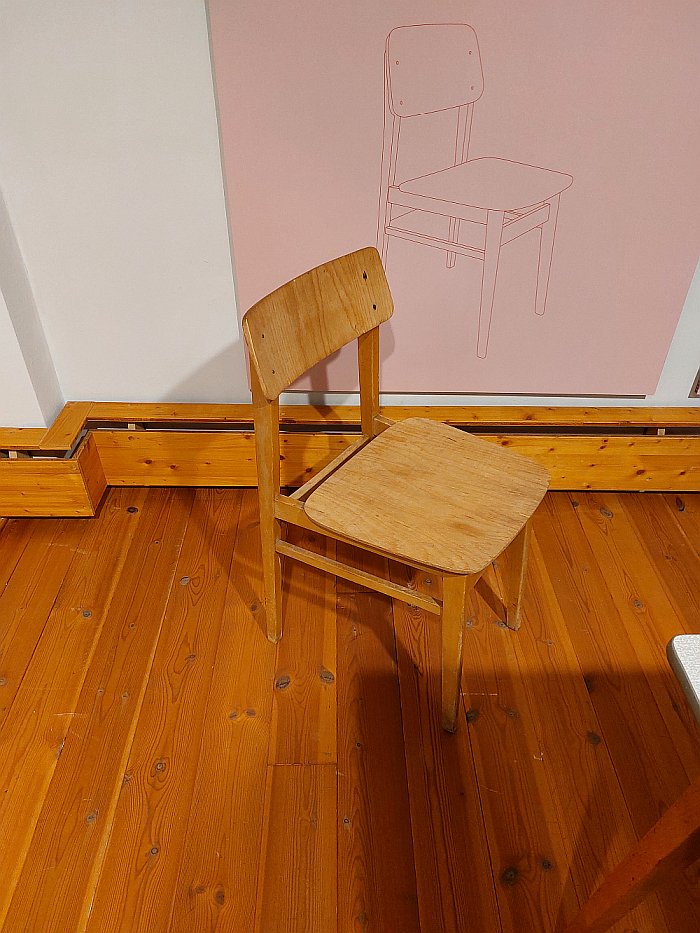
In 2021 Jacob acquired his first 'Scandinavian' chair, if by then a 'Scandinavian' chair that he was increasingly aware was very closely, and very singularly, associated with the DDR, and acquired it in a manner highly informative of the biography of the work: while visiting a craft manufacturer in Seiffen, Erzgebirge, in context of a semester project at Schneeberg, there stood a 'Scandinavian' chair waiting to be thrown in the shredder, waiting to be reduced to wood chippings, a fate already experienced by hundreds of thousands of its relatives across the lands of the former DDR in the, then, 30 years since the fall of the Berlin Wall, Jacob asked if he could have it, the company owner said yes.
An act that not only saved that one chair, but also allowed that one chair and its relatives, those both still amongst us and those long since lost to the shredder and the fire, to begin to shake of the shroud of anonymity that had fallen over them in those 30 years.
A process that began shortly after that fateful day in Seiffen in context of a public symposia in Chemnitz, where Jacob discussed, and praised, the 'Scandinavian' chair; a presentation, a laudation, which led to an interview with the Chemnitz Freie Presse in which Jacob asked anyone with stories or information to get in touch, a more hopeful request than hope filled, "I didn't think the world would be interested in an old kitchen chair". Mistakenly. "On the day the article was published my email inbox rang every few minutes! I was thrilled but also overwhelmed by this flood. I answered the first few messages personally, but then I couldn't keep up. Besides the professorship, I simply didn't have the resources. A year later I still received letters from people who were happy that "their simple chair" was suddenly being appreciated".
A response that confirmed Jacob's growing suspicion that the 'Scandinavian' chair wasn't but was in fact a 'DDR' chair. And an interest in an "old kitchen chair", a "simple chair" and a delight that an anonymous, everyday, DDR chair was being treated as, appreciated as, a design object, that recognition of DDR era design as having a value, as being as relevant as design from other countries, which, and as discussed in context of, for example, German Design 1949–1989. Two Countries, One History at the Kunsthalle im Lipsiusbau, Dresden, and also in a wider eastern European context from Retrotopia. Design for Socialist Spaces at the Kunstgewerbemuseum, Berlin, got lost in the years following 1989, that also made it clear to Jacob that his research was more than just a private questioning, and that it thus required a more structured approach.
The first major step to that more structured approach coming when Frank Göhler from Mulde, Erzgebirge, based manufacturer Göhler Sitzmöbel provided Jacob with a DDR era sales pamphlet in which for the very first time in the course of the research the designation 'EW 1192' appeared. That anonymous chair was no longer, it had a name. A shortly after a parent: Jacob's wife Martha, a jewellery designer by trade and co-collaborator in context of the EW 1192 project, unearthing the information that Horst Heyder was the designer, "one of the very rare pieces of information we actually got from online research", as Jacob recalls. A telling fact in context of the availability, or not, of reliable sources of meaningful information on DDR design beyond the malevolent gaze of toxic 'Ostalgie'. The rest of Martha and Jacob's information coming from offline research, archives, interviews with contemporary witnesses, and through the assistance of the Deutsches Stuhlbaumuseum, who proved an important partner in the research, not least in context of the Entwicklungsbüro Waldheim, that other central component in the (hi)story of not only the EW 1192, but of furniture design in the DDR.
Research that as it progressed, that as more details came to light, that as the EW 1192 increasingly took a place at the centre of furniture design and provision in the DDR, as the EW 1192 increasingly became an important and informative piece of design in its own right, not only tended to confirm that Jacob's early fascination with the 'Scandinavian' chair was justified, that the young, inexperienced, Jacob had correctly understood something of intrinsic value in an anonymous object, even if he did initially misread it, but which also ultimately led Jacob and Martha to develop an exhibition on the EW 1192. To develop Der ungesehene Designklassiker.
An exhibition which also led to Jacob re-designing the EW 1192. Or perhaps better put, led Jacob to consider a re-edition of the EW 1192 that became a re-design. And itself a component of the journey of discovery towards the EW 1192, a component of the EW 1192 reclaiming its biography.
"I was undecided whether it should be a particularly faithful replica or not", Jacob recalls of the earliest considerations on a re-edition, "however the conversations with Klára Němečková [from the Kunstgewerbemuseum Dresden] helped me to get a clearer answer. She concerns herself academically with DDR design and the designers behind it, and considers designers like Rudolf Horn and Horst Heyder to be very großzügig, selfless, unpossessive, with their designs, as they mostly designed as a collective, sharing probably came naturally to them. They were also very much in favour of, proponents for, using the latest technologies and designing in a contemporary way. Products and magazines from then show that the designers of the DDR were up-to-date with what was going on in the world, not in sense that they were 'trendy', certainly not, they were designs whose quality is stable over time yet you can still tell what time they come from".
A time where chairs such as the EW 1192 needed to fulfil functions and roles that today are much less in demand, or perhaps more accurately put are different, have changed; changes in domestic arrangements, changes in domestic realities, that "something is happening to the way people live" of a Nanna Ditzel, those changes in relationships with furniture, those natural, ongoing, unending, changes over time as recorded and explored in, for example, Home Sweet Home. The Archaeology of Domestic Life at SMAC, Staatliches Museum für Archäologie Chemnitz. And also changes to the demands on furniture in public space contexts, for lest we forget, for all that the EW 1192 is today most most popularly know as, and most popularly remembered as, a kitchen chair, as Granny's kitchen chair, it was always a chair for public and domestic spaces.
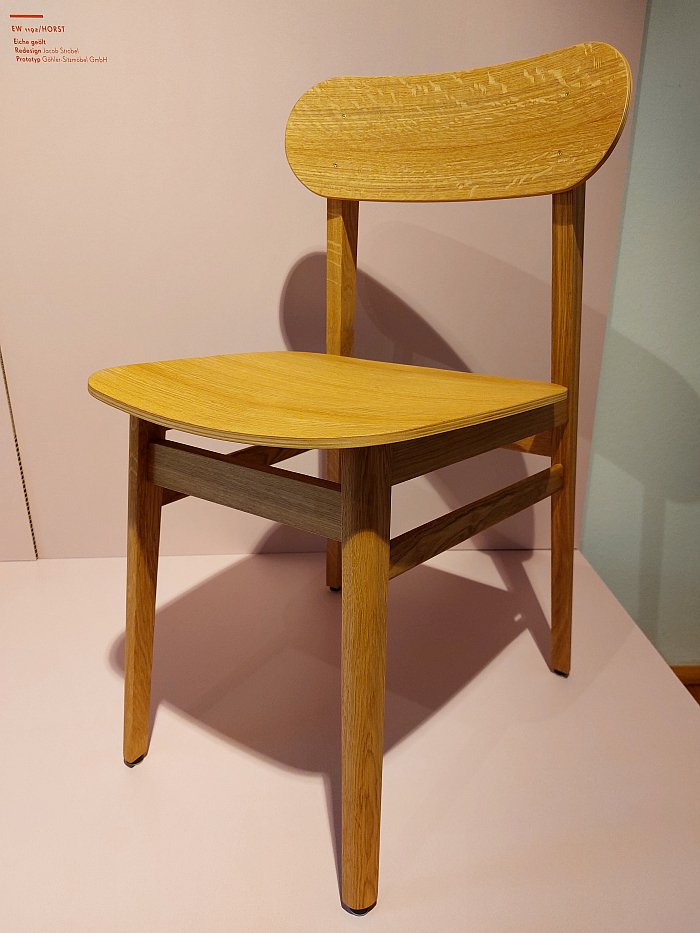
In addition came the appreciation through the research that an EW 1192 as such didn't exist. Or perhaps more accurately, and as previously noted from Rabenau, although Horst Heyder, and, one presumes, his team at the Entwicklungsbüro Waldheim, had designed a chair, more accurately a family of chairs, it was produced within the complex realities of the DDR furniture industry, realities of which Form+Zweck editor Hein Köster once opined "überall geht es anders zu",1 'things are different everywhere', and thus each of the seven (known) production locations had their own approach to the EW 1192, each factory making slight adjustments to, for example, the manner in which the seat is attached to the frame or the shape of the backrest. Adjustments and changes much to the amusement of Jacob, "today a designer would be absolutely livid if a manufacturer slowly started to change their design", the smile on his face growing with the thought, however, as he continues, "at that time, this chair design was probably a kind of common property and each location felt entitled to change it according to its own technical possibilities". A reality that on the one hand allows one to approach the EW 1192 as a Platonic archetype, and on the other allows one to appreciate that industrial furniture production needn't necessarily mean standardised uniformity, can include degrees of variation, a not unimportant appreciation as we move forward and seek to, must, better align our need for meaningful goods with social and environmental realities. And also allowing for differentiated, rare, perspectives on the realities of the DDR furniture industry, and on the provision of furniture in the DDR.
An appreciation of the EW 1192 as a proposition rather than a product, as an archetype rather than a thing, that can also be approached in Der ungesehene Designklassiker via those models which their users have adapted; something perhaps most elegantly expressed in carpenter Dietmar Gundermann's stackable version developed for the Landeskirchlichen Gemeinschaft in Lauter-Bernsbach, Erzgebirge. One can, should, must, reflect on the formal expression of the solution, but must take delight in the fact it was done, and for all delight in the fact that it was done to extend the life of perfectly good chairs in context of a new reality, new demands. To save them from the shredder. Or the fire.
And an increasing understanding of the (hi)story of the EW 1192, an increasing appreciation of the complexities of that apparently so simple wooden chair, an increasing appreciation of design, design culture, design practice, of designers, in the DDR, that led Jacob to the afore opined position that he "must" re-design it: "it would make no sense to leave the chair design exactly as it is", he argues, "it was designed 50, 60 years ago, for 50, 60 years ago, was designed for the shortage economy, designed for the kitchen, and I think it would be false romanticism to do everything exactly the same again now. If it is produced now then not with a glorified nostalgic gaze, but according to the standards of what is currently technically possible, what corresponds to the spirit of the times today and to contemporary needs. And, I think, it does justice to the attitude of the designers back then when I design for our present based on their example, because they absolutely designed for their present".
To that end while Jacob has maintained, for example, the mortise and tenon joints, the arrangement of the stretchers, the visual lightness through an efficient use of material or the screws holding the backrest to the frame, a construction aspect that, then and now, resembles an afterthought, but a most endearing one, he has made adjustments to, for example, the backrest, the seat or the silhouette, some of the more quadratic lines have been smoothed and rounded, and the object as a whole is a little larger, roomier, freed as it is from the need to fit snugly in a 1960s DDR kitchen. And also now comes with the possibility of different foot glides/pads for differing floor types, a glaring omission from Horst Heyder's EW 1192 that one only sees because Jacob added it. Because Jacob was able to add something Horst didn't have access to, that wasn't a thing in the 1960s. Because Jacob brought the EW 1192 into the 21st century rather than seeking to bring the 1960s into the 21st century.
The result is an object that while unquestionably an EW 1192, equally unquestionably isn't a 1960s (kitchen) chair. And is also, for Jacob, a second question: "is this product so good that it not only worked back then when people had no choice, but can it also work today when there is a flood of competing products?"
¿Can it?
¿Kann es?
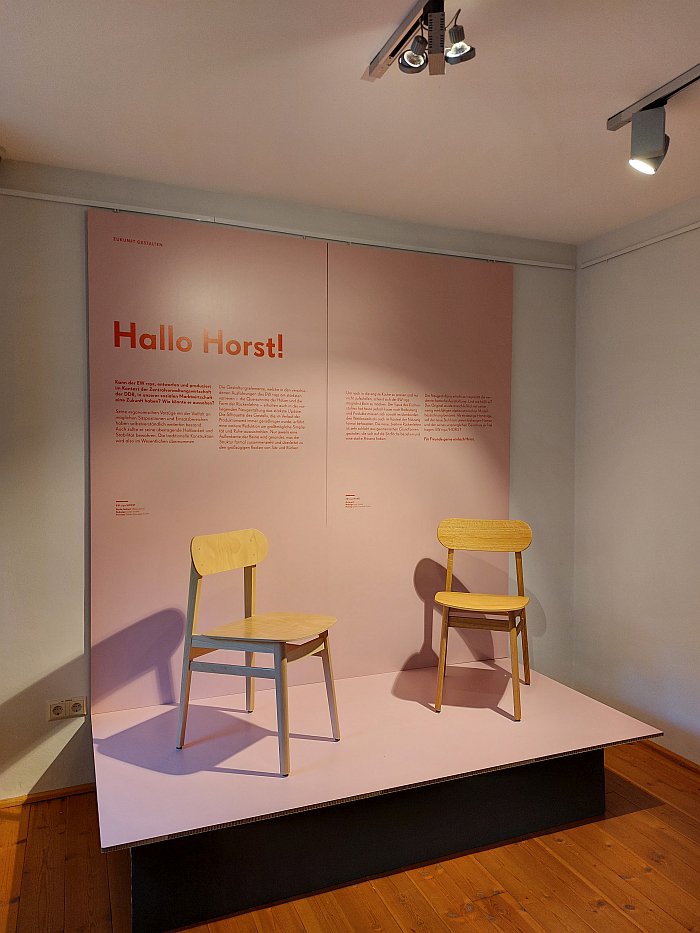
A question there is only one way to answer.
Thus Jacob is currently in the process of sourcing a partner to distribute his EW 1192 Horst, or simply Horst amongst friends, watch this space for updates; the production location has however been decided, and that not by Jacob alone, "it is important to me that it is produced in the Erzgebirge. Part of the question as to whether you are allowed to re-design the EW 1192 is what is part of the DNA of this product? And I think manufacturing is part of it".
DNA that is not only that which defines a species and an individual, but which is also central to evolution in that with time it changes to allow for better adaptation to contemporary conditions; that thing that 1950s and 60s 'Scandinavian' chairs can't do. Aren't allowed to do. Cloned as they are by the contemporary 'Scandinavian' furniture industry. 1950s and 60s 'DDR' chairs can however evolve, and as the EW 1192 eloquently and elegantly demonstrates always have, always have adapted, and have always understood why adaptation and evolution are important. While never losing those factors that make it uniquely distinguishable, always remaining intimately linked to its distant forbearers.
A necessary evolution in furniture that is very much that demanded and advocated by a Kaare Klint, that Grand Doyen of furniture design in Denmark, and which therefore, arguably, makes the EW 1192 Horst more 'Scandinavian' than most 1950s and 60s 'Scandinavian' chairs on the market today. Means the young, inexperienced, Jacob may have correctly read the EW 1192 all along.
A necessary evolution in furniture that is also a component of the questioning of "classic" in terms of furniture design enabled, demanded, by Der ungesehene Designklassiker. Is 'classic' something that stands frozen in time on a pedestal in a museum and/or in a manufacturer's portfolio? Or is 'classic' something that changes in harmony with, and in context of, changes in a society? Or is 'classic' a lazy term we all really need to move on from?
And a necessary evolution that means while Horst Hedyer's EW 1192 will continue to remain a regular sight, robust, durable, responsive and accommodating as they are, or are when spared the shredder and the fire, that Horst Hedyer's EW 1192 will still be around in that coming future where no-one has a personal memory of the DDR, where all know it but from hearsay and (hi)story books, they could, potentially, be joined by a younger generation of chairs carrying that which is inherent in Horst Heyder's work forward for that future society that doesn't know the DDR but which can benefit from the furniture designed there.
A younger generation of chairs carrying the name Horst, and thereby contributing more to keeping the memory of, works of and positions of Horst Heyder and the Entwicklungsbüro Waldheim active and relevant than a museum exhibit ever could. Which is also a valid argument for re-designing a work such as the EW 1192.
Hallo Horst!
Der ungesehene Designklassiker is scheduled to run at the Deutsches Stuhlbaumuseum, Lindenstraße 2, 01734 Rabenau until Sunday March 3rd.
Full details can be found at https://deutsches-stuhlbaumuseum.de (German only)
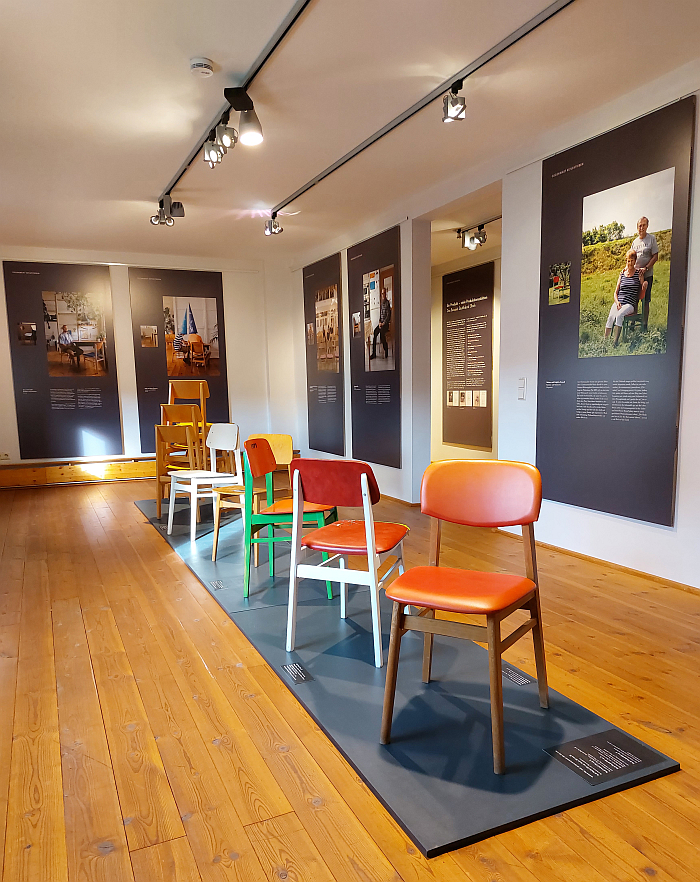
1Hein Köster, Die Erste Jahre, Form+Zweck, Vol. 11, Nr. 5, 1979 page 19 (available via https://digital.slub-dresden.de/werkansicht/dlf/131321/1 accessed 18.02.2024 And as ever at this juncture a million and one thanks to the glorious people at the Sächsische Landesbibliothek – Staats- und Universitätsbibliothek, SLUB, Dresden for digitalising Form+Zweck as full text OCR and making them freely available. You're brilliant!!